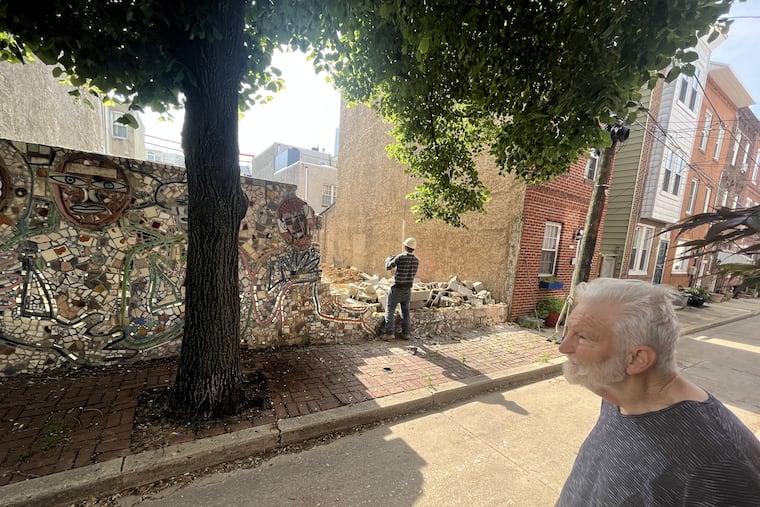An Isaiah Zagar mosaic’s unexpected demolition prompted a frantic neighborhood response in Bella Vista
Isaiah Zagar's mosaics are ubiquitous in Philadelphia, but few are safe from demolition.

On a throughway nestled in Bella Vista, the neighbors pride themselves on the mosaics by Philadelphia artist Isaiah Zagar that glitter along the narrow street.
“It’s absolutely beautiful,” Kay Healy said of one of the mosaics near her home that depicts a row of figures, their faces adorned with plates, cups, silverware, and even doll parts. “It’s a part of our neighborhood’s history.”
So she was stunned to see it being demolished Friday morning.
“No!” she recalled shouting when her daughter’s babysitter told her about the contractors pulling down the artwork.
In the hours that followed, Healy and her neighbors swarmed the construction site on the 700 block of South Mildred Street to slow or stop the work. Meanwhile, art preservationists rallied in what they described as another episode in an often frustrating quest to preserve ubiquitous yet vulnerable public works by one of Philadelphia’s most iconic artists. In the end, they could only celebrate a partial victory. The demolition paused to allow the preservationists to act, but most of the mural is still doomed.
“This happens to us a lot,“ said Emily Smith, executive director of the Magic Gardens, a South Street museum that displays Zagar’s work. “Sometimes the best you can hope for is just salvaging what you can.”
Zagar originals
Most Philadelphians have encountered Zagar’s mosaics, though it’s far more likely they’ve seen them on a walk than in a museum. His sparkling mosaics assembled from chips of glass, tile, and broken household items that depict abstract patterns, shapes, and naive-style figures are particularly common on walls in South Philadelphia. He’s been making them since 1968, Smith said, and there are about 220 throughout the city.
Most, though, are on private property, and are not protected from the demolition that accompanies development, she said.
» READ MORE: The Painted Bride Art Center has been sold with its signature mosaic intact
“If the owner doesn’t care there’s very little we can do,” Smith said.
That is the case on Mildred Street, where developer Noah Ostroff plans to build a 10-unit apartment complex on land that had been a parking lot, according to property records. Zagar’s mosaic is on a roughly 10-foot-tall, 20-foot-long wall on that property. Staff at the Magic Garden knew the work was likely to be destroyed at some point, but didn’t know when.
Ostroff declined to comment Friday.
A frantic preservation
Mildred Street residents sat in folding chairs across the street in protest Friday morning. Zagar himself briefly visited the site.
Healy and another resident, Will Gross, said they had a tense conversation with contractors as they tried to stop the work. The damage had already been done. The right side of the mosaic was gone. Shards of glass and tile glittered on the sidewalk.
“It was heartbreaking,” Gross said. “Isaiah is such a treasure of the city.”
Meanwhile, Healy, who used to work as a tour guide at the Magic Gardens, called Smith. She arrived with two others, Stacey Holder, the Magic Gardens’ preservation manager, and Silke Tudor, part of the museum’s education team, to see what they could rescue before next week. Zagar’s work is so frequently destroyed recovery efforts are now almost routine.
» READ MORE: Magic Gardens creator Isaiah Zagar turns 80 on Monday — and you’re invited to celebrate
“Sometimes that’s just how a Friday goes,” Smith said. “It’s just, alright, cancel all my meetings.”
Zagar did not want to comment, Smith said, but asked that she pass along that it was wonderful to see how much the community cared about his work.
With a lot of chiseling, drilling, and careful maneuvering, Smith and her crew could salvage intact what they called blobs, the figures’ faces. Zagar made them off-site and installed them on the walls. The Mildred Street mosaic had four remaining faces, and Smith, Holder, and Tudor removed three intact by midafternoon. A third shattered in the process.
The faces will temporarily be stored in a home on Mildred Street, Smith said, and she hopes to eventually add them to a similar mosaic. It won’t be a precise replica, though. Finding exactly the same shards of ceramic and glass would be virtually impossible, and in any case Zagar isn’t interested in exactly copying older work. Spontaneity is part of his process, Tudor said.
The Magic Gardens does make Zagar-style mosaics, but the artist, who is 84, no longer produces new works, Smith said.
As Holder balanced on a ladder, chiseling at the last face, a pair of passing workers stopped to chat. They were renovating the nearby Church of the Crucifixion, and knew Holder because the church also has a Zagar mosaic. The workers mentioned offhandedly they destroyed parts of Zagar’s work Friday, and Holder gaped. She was supposed to have been notified before that work began, she said.
“There were a lot of unique tiles, even some that were handmade,” she said.
She paused before turning back to the last face on the Mildred Street mosaic.
“So that happens,” she said, resigned.
Staff writer Jake Blumgart contributed to this article.